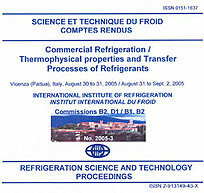
Document IIF
Système frigorifique d'une patinoire employant le CO2 en tant que frigoporteur.
Ice rink refrigeration system with CO2 as secondary fluid.
Auteurs : ROGSTAM J., SAWALHA S., NILSSON P. O.
Résumé
CO2 as a phase changing secondary fluid has advantages compared to traditional secondary fluids where the low pumping power required is the most dominant. This technology has gained a lot of ground in the supermarket field recently. Among energy-consuming refrigeration applications ice rinks can be mentioned as a significant example, therefore this application is of potential interest for a pumped CO2 solution. A miniature ice rink has been built to evaluate CO2 as secondary fluid. In a few reference plants, CO2 has already been used in a steel pipe system. Steel pipes have an inherent high installation cost, so this study proposed to evaluate the use of copper tubes in the ice rink floor. The copper tube circuits were 60 m long and covered in concrete according to the standard construction method. The system was instrumented to evaluate the pressure drop and heat transfer in the tubes. The investigation proved that the copper tube concept can be used in full scale plants, and a significant cost saving can be achieved compared with a steel pipe installation. The pump power is significantly less compared with a traditional ice rink and the yearly energy saving for a full scale indoor ice hockey facility is about 150 000 kWh.
Documents disponibles
Format PDF
Pages : 2005-3
Disponible
Prix public
20 €
Prix membre*
Gratuit
* meilleur tarif applicable selon le type d'adhésion (voir le détail des avantages des adhésions individuelles et collectives)
Détails
- Titre original : Ice rink refrigeration system with CO2 as secondary fluid.
- Identifiant de la fiche : 2006-0621
- Langues : Anglais
- Source : Commercial Refrigeration. Thermophysical Properties and Transfer Processes of Refrigerants. Proceedings of the IIR International Conferences.
- Date d'édition : 02/08/2005
Liens
Voir d'autres communications du même compte rendu (140)
Voir le compte rendu de la conférence
Indexation
-
Efficient and ecological system for an artifici...
- Auteurs : HERA D., DRUGHEAN L.
- Date : 06/05/2005
- Langues : Anglais
- Source : Ammonia Refrigerating Systems, Renewal and Improvement.
- Formats : PDF
Voir la fiche
-
Ice rinks using carbon dioxide as secondary ref...
- Auteurs : ROGSTAM J.
- Date : 13/06/2010
- Langues : Anglais
- Source : IIR/Eurotherm sustainable refrigeration and heat pump technology conference. Proceedings of the Eurotherm Seminar No. 88, Stockholm, Sweden, June 13-16, 2010.
- Formats : PDF
Voir la fiche
-
Ice rink refrigeration system with carbon dioxi...
- Auteurs : NILSSON P. O., ROGSTAM J., SAWALHA S., et al.
- Date : 29/05/2006
- Langues : Anglais
- Source : 7th IIR-Gustav Lorentzen Conference on Natural Working Fluids (GL2006). Proceedings
- Formats : PDF
Voir la fiche
-
Natural working fluids in artificial skating ri...
- Auteurs : BERENDS E.
- Date : 29/05/2006
- Langues : Anglais
- Source : 7th IIR-Gustav Lorentzen Conference on Natural Working Fluids (GL2006). Proceedings
- Formats : PDF
Voir la fiche
-
Aqua ammonia as secondary refrigerant in ice ri...
- Auteurs : ROGSTAM J., BOLTEAU S., GRÖNQVIST C., et al.
- Date : 24/08/2019
- Langues : Anglais
- Source : Proceedings of the 25th IIR International Congress of Refrigeration: Montréal , Canada, August 24-30, 2019.
- Formats : PDF
Voir la fiche
